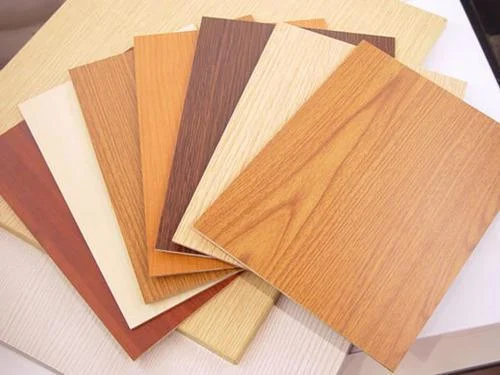Among the several types of plywood for furniture, BWR sheets are preferred for both interiors and exteriors. In fact, BWR plywood even tops the list when it comes to cupboard requirements in kitchens and bathrooms. This is because it has resistance to boiling water for up to 8 hours.
What is plywood?
Plywood is a composite wood product. It is produced using wood veneers stripped from wood logs from hardwoods, softwoods, and more. These wood veneers are typically glued but higher-grade plywood is pressed and heated through more elaborate processes. The best angle should be taken before binding the wood veneers together so that the wood grains are preserved.
Plywood is more preferred over 2×4 logs because they have more stable surfaces. This is because of the fact that plywood does not expand even when there is moisture across the board’s grain. Aside from this, the processes that plywood goes through, makes it resistant to cracking, shrinking, breaking, and warping.
There are many types of plywood but generally, the thickness of each is based on the number of plies it has. The most common plywood is 3-ply. The sturdier ones come in 5-ply or multi-ply.
17 Types of Plywood
As has been said, shopping for the right plywood type for your home projects is not a walk on the beach. With this, you need to be acquainted with the following types of plywood.
1. Softwood Plywood
The name suggests that this type of plywood was made out of softwoods like redwood, cedar, or pinewoods. Although these woods are generally pitted against the sturdier hardwoods, you would be surprised to know that softwood plywood is used for heavy woodworks. This includes roof sheathing, laid down as home subfloors, and frame sheathing for home exteriors.
Other uses of softwood plywood would be in constructing tool sheds at home, shelves, and dog houses.
2. Hardwood Plywood
In contrast, this type of plywood is made of wood veneers from walnut, oak, maple, and birch woods. Usually, hardwood plywood is made of seven and more layers making them very sturdy. Manufacturing this needs gluing the veneers at the right depth and angle to support heavy woodwork projects.
Hardwood plywood is used for projects which need a durable frame like musical instruments, wood casings, sports equipment, and of course, in making furniture.
3. Aircraft Plywood
This one is considered one of the most durable and highest-grade plywood out there. It is made specifically from hardwoods that are not vulnerable to moisture and too much heat such as birch and also mahogany.
Aircraft plywood is made of thinner wood veneers to keep it lightweight and more workable. With these features, aircraft plywood is usually used for aircraft building, rafters and boats, furniture that is meant to carry heavier loads, and buildings that require industrial-strength plywood.
4. Exterior Plywood
As the term implies, this type of plywood is used for exterior woodworks. As such, it is manufactured and glued using water and weather-resistant adhesive. Good quality exterior plywood will provide strong wood frames for many decades.
This type of wood is categorized as a multi-ply. Note that each location would have different weather conditions. It is because of this reason that oak exterior plywood has greater leverage among the various types of exterior plywood as they are mold and mildew-resistant even in extra-moist locations.
5. Lumber Core Plywood
This one is specifically designed 3-ply. Usually, it is made by laying down a thick wood core and gluing two thin wood veneers on each of its sides. The outer surface of lumber core plywood is made of hardwood like birch, maple, and oak. The inner layers are made of strips of various types of softwood glued together, forming a sturdy wood slab.
Having a softer interior gives it more value for projects that need to be nailed and screwed as you can easily attach them to the softer interior. This is quite a gamble, however, because if you choose wrongly, the nails and screws might not hold.
6. Marine Plywood
This is not water-resistant plywood albeit the label. Being the most common plywood yet most high-grade constructed plywood, you have to understand that the term reflects more the grade of the plywood, which is marine-grade using waterproof adhesives. As a plywood type, it is distinguishable with the absence of knotholes.
This one is often made of firwood or larch, making it durable and sturdy. However, it is manufactured raw, without chemicals. As such, it is not resistant to rot, mildew, and molds. It is used mainly for exterior structures such as plant boxes, benches, decks, and gazebos.
7. Overlaid Plywood
It gets its name for having an overlaid surface giving off a strong wood finish look. It follows the regular way of making plywood which is gluing wood veneers using waterproof adhesives. However, overlaid plywood comes in either medium or heavy density because the wood veneers are bonded in high heat and pressure processes.
High density overlaid plywood is more expensive than medium overlaid plywood because more resin is poured into them. The smooth wood finish on the surface is more for function than aesthetics. Through this, you can depend on its durability while avoiding dust and water particles from damaging the wood. This also makes it scratch-resistant.
8. Structural Plywood
It is also called sheathing plywood because of its known durability both in framing and building. The strongest, most waterproof glues are used in manufacturing structural plywood. Usually, they are graded as C or D. And although they are very durable, they cannot be graded higher because they will become expensive for construction.
Structural plywood is, however, not that flexible when it comes to harsh weather conditions. Nonetheless, they are still the favorite choices for indoor and outdoor woodworks.
10. Flexible plywood
As the name suggests, flexible plywood is for curves and bending. As such, it is used for the curved parts of construction frames and also in furniture making. It is made out of a cross-grained central ply and thicker cross-grained plys on both sides. To get a shinier surface, overlaid wood veneers are added to the front surface.
In the UK, it is often referenced as the hatters ply since they were once used in making stove-pipe hats during the Victorian era.
11. Construction Plywood
This one is an umbrella term for many products. It is divided between structural and non-structural panels in which particleboards, MDF core ply, and foam boards, among others, are included. The non-structural boards may look soft but all construction plywoods are incredibly sturdy.
12. Veneer core plywood
This is distinguishable for its odd-numbered veneers in its core. It is usually constructed with a center veneer and on its sides are alternately glued cross-grained veneers. It is all-around plywood because it has the ability to hold greater weight, has the softness that allows nail and screw holding and the flexibility to be bent in curves.
13. MDF core
It is often contrasted to particleboards. The main difference is that the MDF core is made out of individual wood fibers. It is very neat to work with since it does not produce wood chips or sawdust. It is also flatter than most softwood ply boards making it the top choice for furniture base.
The only downside to this plywood type is that it is heavier than most types of plywood.
Compared to particleboard, it is sturdier and more durable.
Plywood grades
Plywood follows a grade-system that tells you the quality of materials used in producing them and the price of the plyboard you will be buying. Typically, plywood grades follow an A, B, C, D system. A is, of course, the highest-grade plywood, and D is the lowest grade for plywood. But this is not the end because most plywood types come in two-letter grades.
You must know that the first letter grade denotes the quality of the front board while the second letter is for the wood grade of the back part. The two-letter grades are usually not similar. This will guide you on which part of the board you will designate as the front and back parts. Of course, the part with the lower grade is assigned as the back part.
Plywood grades will also guide you in terms of what they are most fit to use for. For example, A-C plywood grades are used for exterior panels and woodworks as they are more durable and water and weather-resistant. C and D grade plywood are more appropriate for interior woodworks but they should be covered adequately.
Regardless of the plywood grade, if the board has an additional letter ‘X’ at the end, this means that the plywood has met all the tests that will qualify it as strong exterior plywood. Of course, for high-end woodworks, grades A-B or CX are the best fit. They usually do not have knotholes giving a more workable surface painting and staining.


